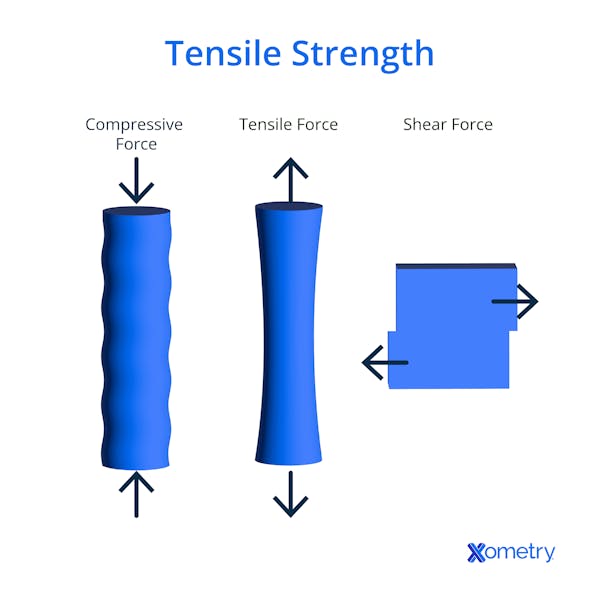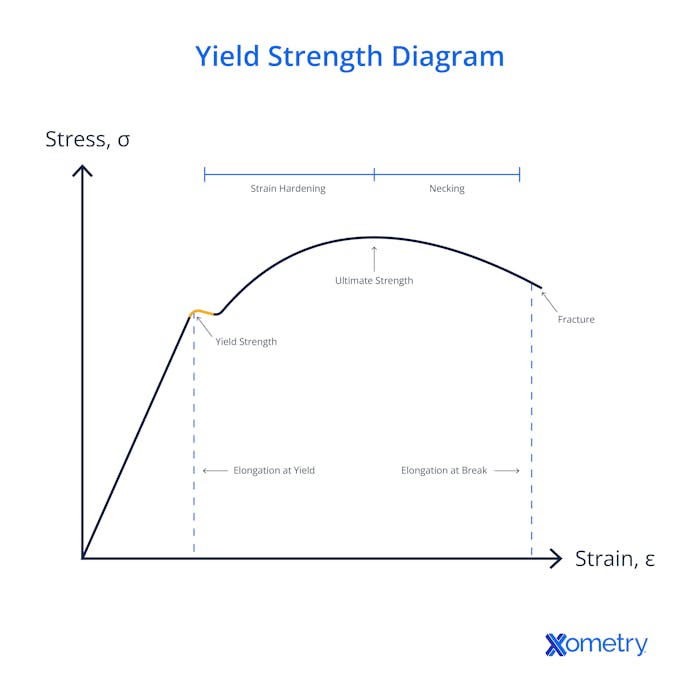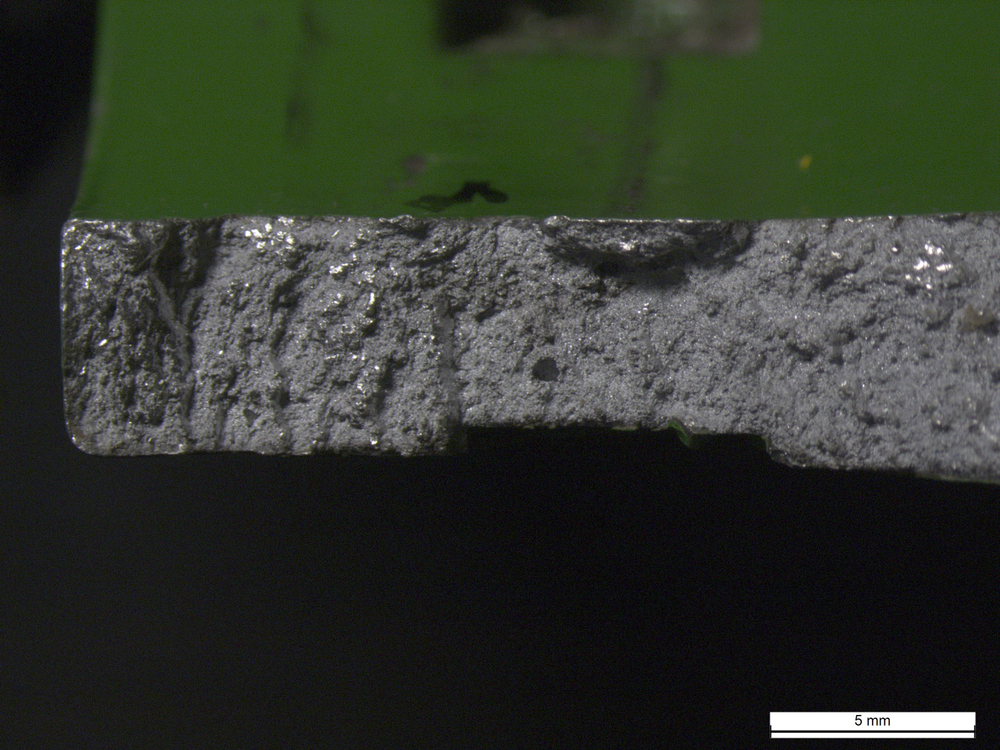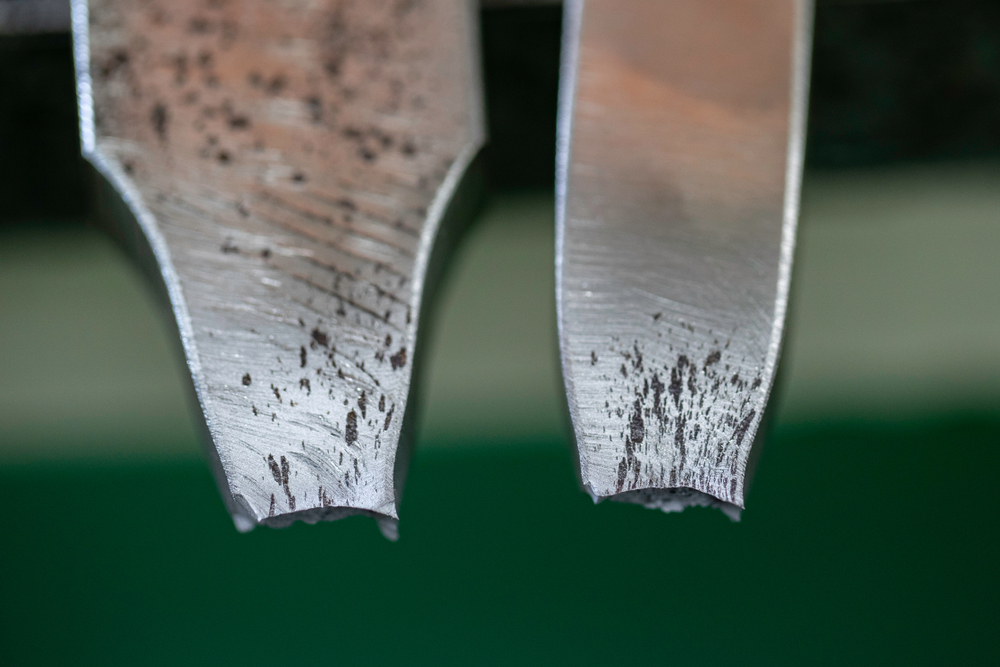For manufacturers, tensile strength is one of the first things needed when it comes to choosing a suitable material for their products. In this article, we’ll cover exactly what it is, how it differs from other similar specs, and how to calculate it.
What is Tensile Strength?
The tensile strength of a material is how much load or pulling force it can take across a specific area before it either permanently stretches or breaks. While its yield strength is the point just before the material starts to stretch in a way that it can’t go back to its original shape, the tensile strength is the point at which it breaks. A material like steel has a high tensile strength, but a rubber band will be right at the bottom of the scale.
For materials that stretch in a predictable way—like a spring, for instance—the response to the force applied, its “elasticity,” will depend on its “linear elastic zone.” If the force is within this zone, the spring will return to its original shape once the force is gone. If not, the material will break or be damaged beyond repair. You can see how tensile force differs from other types in terms of its direction in the below diagram.

Tensile Strength Calculation
To correctly measure tensile strength, we divide the force per unit of a cross-sectional area of the material instead of its whole surface. But you won’t be able to calculate a material’s tensile strength directly without first knowing its stress-strain curve. Don’t worry, we’ve got an article that tells you exactly how to figure this out. You’ll then perform the below equation:
σ = F/A – eq 1
- σ = stress
- F = force
- A = area
The SI tensile strength unit is MPa (N/mm2). Basically, the strength equals the stress at the point of failure of the material, and this failure point can be characterized by the force per unit area.
Types of Tensile Strength
There are a few different types of tensile strength, but the term can mean whatever is most useful to you. For example, figures worked out under standard conditions will be the most useful to engineers who want to compare material formulations or lots, or those who are trying to figure out whether a material will be good for a particular task. The most common types used are yield strength, ultimate tensile strength, and breaking strength, and we’ll look at these in a little more detail below.
Yield Strength

As mentioned a little earlier, yield strength is the point at which permanent (or plastic) deformation begins in a material. For steel, this is once it’s been deformed past its proportional limit, usually seen as a straight line on a stress-strain curve. For material without a distinct yield point, like aluminum, yield strength is reported as the stress that coincides with 0.2% strain. In most cases, metal parts are designed to keep stresses in the service environment below the yield strength. In the case of very brittle materials, like ceramics, these will fail at very small deformations and do not yield at all. Other materials, like elastomers, can be stretched many times their original length without breaking and only show a small amount of permanent deformation once the load has been removed.
Breaking Strength
Also known as fracture strength, this refers to the point at which the material can no longer carry any more load and breaks. This can be seen as the end point of a stress-strain curve, i.e. point “ε” in the yield strength diagram above. The breaking point is also the point used for measuring total elongation.
Ultimate Strength
This is the maximum stress a material can handle before it ends up breaking under a tensile load. Some metals will experience strain hardening after passing their yield point, and they’ll continue to deform as the stress increases until they get to the material’s ultimate tensile strength. Not all materials, for instance plastics, will have a well-defined ultimate tensile strength.
Material Tensile Strength Examples
Each class of material has a different behavior when under a tensile load. Ductile materials like low-carbon steel will plastically deform before failure, but more brittle materials, like high-carbon steel, will have very little deformation before failure. We’ve put some common materials in the table below along with their tensile strengths.
| Material | Yield Strength in Tension (MPa) |
|---|---|
Material AISI 1018 Mild Steel (Cold Drawn) | Yield Strength in Tension (MPa) 370 |
Material Tungsten | Yield Strength in Tension (MPa) 750 |
Material Type 316 Stainless Steel (Annealed) | Yield Strength in Tension (MPa) 434 |
Material Copper (Annealed) | Yield Strength in Tension (MPa) 33.3 |
Material 230 Brass (OSO70 Temper) | Yield Strength in Tension (MPa) 69 |
Material T6061-0 Aluminum | Yield Strength in Tension (MPa) 48.3 |
Material ABS | Yield Strength in Tension (MPa) 44.9 |
Material Nylon 6 | Yield Strength in Tension (MPa) 63.6 |
Table Credit: https://matweb.com/
Tensile Strength Impactors
Tensile strength can be affected by various factors, such as.
- Temperature: A material’s tensile strength usually goes down when its temperature rises. Below room temperature, most materials become slightly stronger, but they’ll also get less ductile.
- Work hardening: The process’s whole concept is to plastically deform a material to make it harder. By rolling, hammering, bending, or stretching a metal, its crystal structure goes through microscopic changes that increase the yield and ultimate tensile strength, while at the same time reducing its ductility.
- Additives: Glass or carbon fiber added to a material can increase the tensile strength of nonmetals, like nylon, for example.
- Heat treatment: Like work-hardening, this also changes a metal’s microstructure and, depending on the type of treatment, could result in either an increase OR a decrease in tensile strength.
- Defects: Surface and internal defects can reduce the tensile strength of a material as they create weak points where cracks are able to start.
Tensile Strength Failure
There are two main types of tensile strength failure: brittle and ductile. Brittle failure (pictured below) occurs mainly with hard materials, like cast iron. The material will not deform much before it suddenly fails.

An example of brittle failure.
Image Credit: Shutterstock.com/lbrumf2
Ductile failure is the primary tensile failure mode for many structural steels and softer materials, like aluminum, and is gradual instead of instantaneous. After the material starts to yield, plastic deformation continues, then localizes, producing a "neck" that will be the site of the material’s final separation. Here’s what a typical ductile failure looks like:

An example of ductile failure.
Image Credit: Shutterstock.com/High Simple
Tensile strength vs. tensile stress: What’s the difference?
A material’s tensile stress is the amount of force per unit area it experiences due to a tension load, but tensile strength is either its yield, ultimate, or fracture strength.
How do yield and tensile strength differ?
The tensile strength of a material shows how well it can resist tension loads applied to it. Several specifically defined tensile strength metrics are valuable to engineers: yield strength, the stress at which a material begins to plastically deform, and ultimate tensile strength, often referred to simply as "tensile strength" for short, which is the maximum stress a material can sustain before failure becomes inevitable.
What’s the best tensile strength for 3D printing?
When designing 3D-printed parts, the material is selected based on the application and not the other way around. It also depends on the type of material and the direction and amount of the loads. For example, if a part is only loaded in compression or if it will be an enclosure for electronics (where anti-static and moisture absorption properties are more important), then tensile strength doesn’t matter much. If the part will be exposed to mechanical loading, you’ll definitely need to know the tensile strength.
For example, if you’re designing a 3D-printed ABS part, then it would be a mistake to use normal ABS properties. 3D printing material may have lower tensile strength compared to the material's theoretical tensile strength based on the 3D printing technology used. Many material data sheets for 3D-printed materials will show the tensile strengths in different directions within the material (commonly in the Z and XY directions). Other 3D printing technologies, such as SLM (selective laser melting), will produce parts with an isotropic structure, which means their properties are equal in all directions.
How Xometry Can Help
Xometry provides a wide range of manufacturing capabilities, including CNC machining, 3D printing, injection molding, laser cutting, and sheet metal fabrication. You can get started today by uploading your designs to the Xometry Instant Quoting Engine®!
Copyright and Trademark Notices
- Inconel® is a registered trademark of Special Metals Corporation.
Disclaimer
The content appearing on this webpage is for informational purposes only. Xometry makes no representation or warranty of any kind, be it expressed or implied, as to the accuracy, completeness, or validity of the information. Any performance parameters, geometric tolerances, specific design features, quality and types of materials, or processes should not be inferred to represent what will be delivered by third-party suppliers or manufacturers through Xometry’s network. Buyers seeking quotes for parts are responsible for defining the specific requirements for those parts. Please refer to our terms and conditions for more information.


